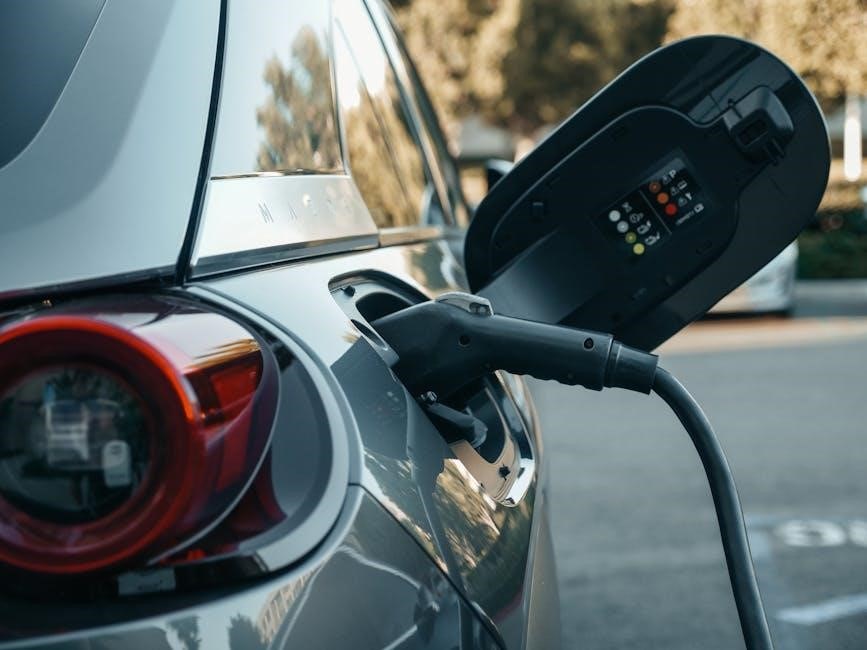Proper installation and maintenance of vessel batteries are crucial for safety‚ reliability‚ and performance. This guide provides comprehensive instructions and best practices for marine battery systems‚ ensuring optimal functionality and compliance with safety standards.
1.1 Importance of Proper Battery Installation and Maintenance
Proper battery installation and maintenance are crucial for ensuring safety‚ reliability‚ and optimal performance. Incorrect installation can lead to electrical hazards‚ such as short circuits or electric shock‚ while poor maintenance may result in reduced battery life and unexpected system failures. Regular inspections and adherence to installation guidelines help prevent these risks‚ ensuring the vessel’s electrical systems operate efficiently and safely. Properly installed and maintained batteries also protect the vessel from potential damage and ensure reliable power supply for essential systems.
1.2 Overview of Battery Types and Configurations
Marine batteries come in various types‚ including Lead-Acid and Lithium-Ion‚ each with unique advantages. Lead-Acid batteries are cost-effective and widely used‚ while Lithium-Ion offers higher energy density and longer lifespan. Configurations vary‚ with Series setups increasing voltage and Parallel setups boosting capacity. Proper selection depends on the vessel’s power requirements and operational needs. Understanding these options ensures optimal performance‚ reliability‚ and safety for electrical systems on board. Correct configuration also prevents overload and ensures efficient energy storage and distribution across the vessel’s systems.

Pre-Installation Checks
Evaluate power requirements‚ inspect battery compartments‚ and ensure compatibility with existing electrical systems. Verify space and ventilation for safe installation and optimal performance of the vessel’s battery system.
2.1 Assessing Power Needs and Battery Capacity
Evaluating your vessel’s power requirements is essential to select the right battery capacity. Consider the energy needed for propulsion‚ lighting‚ and onboard electronics. Calculate peak demand and average usage to determine the appropriate battery size. Ensure the chosen battery type‚ whether lead-acid or lithium-ion‚ matches your power needs and provides reliable performance. Proper assessment prevents underpowering or overloading‚ ensuring efficient and safe operation of your marine electrical systems.
2.2 Understanding Battery Space and Compartments
Ensure your vessel’s battery compartment is properly designed and ventilated to accommodate the battery system. Securely fasten batteries to prevent movement during operation. Use compartments with adequate space to avoid overcrowding‚ ensuring proper airflow and heat dissipation. Protect batteries from exposure to water‚ moisture‚ and extreme temperatures. Follow ventilation guidelines to safely release hydrogen gas‚ especially in enclosed spaces. Proper compartment design enhances safety‚ prevents damage‚ and ensures reliable battery performance during vessel operation.
Installation Process
Install the new battery securely in the compartment‚ ensuring proper orientation and alignment. Connect the positive terminal first‚ followed by the negative‚ tightening all connections firmly for reliable power and safety.
3.1 Disconnecting the Old Battery
Before replacing the old battery‚ ensure the marine battery switch is turned OFF to prevent electrical shocks or damage. Start by disconnecting the negative (black) cable from the old battery‚ followed by the positive (red) cable. Gently pull the cables away from the terminals to avoid damage. Once disconnected‚ carefully lift the old battery out of its compartment‚ taking note of its position and orientation for proper removal. Always wear protective gloves and eyewear to ensure safety during this process. Double-check that all connections are fully detached before proceeding.
3.2 Seating the New Battery and Connecting Terminals
Place the new battery securely in the compartment‚ ensuring it is properly seated and aligned to prevent movement. Connect the positive (red) cable to the positive terminal and the negative (black) cable to the negative terminal. Tighten the terminal nuts firmly but avoid over-tightening. Double-check that all connections are secure and correctly oriented. Ensure the battery is stable and protected from heat sources or electrical hazards. Proper installation ensures reliable power supply and safety on board. Always follow manufacturer guidelines for terminal connections and battery placement.

Maintenance and Troubleshooting
Regularly inspect battery terminals for corrosion and clean as needed. Check electrolyte levels and top up if necessary. Monitor voltage and temperature to prevent overheating and ensure optimal performance.
4.1 Regular Inspection of Battery Connections and Electrolyte Levels
Regular inspection of battery connections ensures reliability and safety. Check terminals for corrosion and tighten loose connections. For flooded batteries‚ inspect electrolyte levels and top up with distilled water if low. Avoid overfilling‚ as it can cause spills during charging. Clean corrosion from terminals using a wire brush and apply a protective coating. Ensure vent caps are secure to prevent acid spills. Proper ventilation in the battery compartment is essential to prevent hydrogen gas buildup‚ reducing the risk of explosion. Regular checks help maintain optimal performance and extend battery lifespan.
4.2 Diagnosing Common Battery Issues
Identify common battery issues by checking voltage levels‚ connections‚ and physical condition. Low voltage may indicate a weak battery or faulty charging. Corroded terminals or loose connections can cause power loss. Inspect for cracks in the casing or swollen batteries‚ which may signal internal damage. Test the battery’s state of charge using a multimeter and ensure electrolyte levels are adequate for flooded batteries. Addressing these issues promptly prevents system failures and extends battery life. Regular diagnostics help maintain reliable power supply for vessel operations.

Battery Types and Configurations
Marine batteries come in various types‚ such as Lead-Acid‚ Lithium-Ion‚ and AGM‚ each suited for different applications. Configurations like Series and Parallel setups optimize power and capacity‚ ensuring reliable energy supply for vessel systems.
5.1 Lead-Acid vs. Lithium-Ion Batteries
Lead-Acid batteries are traditional‚ cost-effective‚ and reliable for marine use‚ offering robust performance in moderate conditions. Lithium-Ion batteries‚ while more expensive‚ provide higher energy density‚ lighter weight‚ and longer lifespans. Lead-Acid batteries are heavier and require regular maintenance‚ while Lithium-Ion batteries are more efficient and suitable for modern vessels with advanced systems. Both types have distinct advantages‚ but Lithium-Ion batteries are gaining popularity due to their superior performance and lower long-term maintenance needs‚ despite higher initial costs and the requirement for a Battery Management System (BMS).
5.2 Series and Parallel Battery Configurations
Series configurations increase total voltage by connecting batteries end-to-end‚ ideal for high-voltage systems‚ while parallel setups boost capacity by connecting batteries side-by-side‚ suitable for heavy power demands. Series configurations are often used for starting engines‚ requiring higher voltage‚ whereas parallel setups are preferred for auxiliary systems needing consistent voltage and higher reserve capacity. Properly matching battery voltage and capacity in series‚ and ensuring equal voltage levels in parallel‚ is crucial for optimal performance and longevity. Both configurations require careful planning to meet specific power needs and ensure system reliability.
Safety Guidelines
Ensure proper ventilation to prevent hydrogen gas buildup. Protect batteries from extreme temperatures and electric shock. Follow manufacturer instructions and safety standards to minimize risks and ensure reliable operation.
6.1 Ventilation Requirements for Battery Compartments
Adequate ventilation is essential in battery compartments to prevent hydrogen gas accumulation; Install vents or openings to allow gases to escape‚ ensuring airflow and reducing explosion risks. Regularly inspect ventilation systems for blockages. For lithium-ion batteries‚ proper airflow helps maintain temperature stability‚ preventing overheating. Ensure all compartments are well-ventilated‚ especially during charging‚ to maintain a safe environment. Follow manufacturer guidelines for ventilation design and maintenance to comply with safety standards and prevent potential hazards.
6.2 Protecting Batteries from Heat and Electric Shock
Protecting batteries from excessive heat and electric shock is critical for safety and longevity. Keep batteries away from direct sunlight and heat sources. Use insulation materials to regulate temperature. Avoid overcharging‚ as it can cause overheating. Ensure all electrical connections are secure to prevent short circuits. Use protective gear like gloves and goggles when handling batteries. Regularly inspect wiring and connections for damage or corrosion. Proper installation and maintenance can significantly reduce the risk of electric shock and heat-related damage‚ ensuring safe and reliable battery performance on your vessel.

Battery Management System (BMS)
A Battery Management System (BMS) monitors and manages battery functions‚ ensuring optimal performance‚ safety‚ and longevity. It regulates charging‚ discharging‚ and temperature‚ preventing overcharge or depletion.
7.1 Functions and Importance of a BMS
A Battery Management System (BMS) monitors voltage‚ temperature‚ and state of charge‚ ensuring safe and efficient battery operation. It protects against overcharging‚ deep discharging‚ and thermal extremes‚ balancing cell performance for longevity. The BMS is crucial for preventing failures‚ extending lifespan‚ and optimizing energy use. By maintaining optimal charging and discharging levels‚ it ensures reliable power supply and reduces risks of electrical hazards. A well-functioning BMS is essential for modern vessel safety‚ efficiency‚ and compliance with marine standards.
Charging Procedures
Charging marine batteries requires following best practices to ensure safety and efficiency. Protect batteries from heat and electric shock‚ and always adhere to the manufacturer’s guidelines.
8.1 Best Practices for Charging Marine Batteries
When charging marine batteries‚ use a high-quality charger designed for your battery type. Monitor temperature and avoid overcharging to prevent damage. Always disconnect the negative terminal first and ensure the charger is set to the correct voltage. Regularly inspect cables and connections for wear or corrosion. Charge in a well-ventilated area to prevent hydrogen gas buildup. Avoid charging near open flames or sparks. Follow the manufacturer’s guidelines for charge rates and maintenance. Proper charging ensures longevity‚ safety‚ and reliable performance of your vessel’s battery system.

Legal and Regulatory Compliance
Ensure your vessel battery system adheres to national and international maritime regulations. Compliance with safety and environmental standards is essential for legal operation and certification.
9.1 Ensuring Compliance with Vessel Battery Standards
Compliance with vessel battery standards is critical to ensure safety‚ environmental protection‚ and legal operation. Adhere to international and national regulations‚ such as those set by classification societies and maritime authorities. Proper documentation‚ including certification and inspection records‚ must be maintained. Battery systems should meet design and installation requirements to prevent hazards. Regular audits and inspections by authorized bodies are essential to verify conformity. Failure to comply may result in operational restrictions or penalties. Always follow guidelines for safe and environmentally responsible battery installations.
